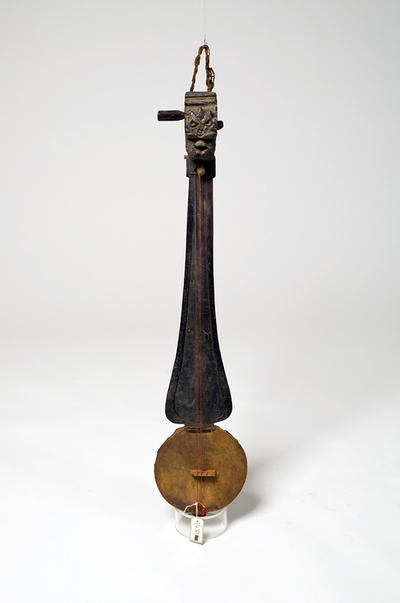Arbajo
Plucked Instruments
Asia
Unknown
Video
The Arbajo (Nepali: आरबाजो) is a traditional four-string lute from Nepal, used as a rhythm instrument, also referred to as a Tālabājā (Nepali: तालबाजा). It is primarily played by the Gandarbha caste of musical performers and is considered the “male” companion instrument to the Nepali sarangi. Despite its historical significance, the Arbajo has declined in usage over time, being gradually replaced by the sarangi.
History and Cultural Significance
The Arbajo holds deep cultural roots within Nepal, particularly among the Gandarbha caste, a community of musicians known for their traditional storytelling through music. It is believed that the Arbajo symbolizes the “male” role, while the sarangi represents the “female” counterpart. Historically, the instrument was played during festivals such as the “Chaiteti” festival and other village gatherings. However, by the late 20th century, the Arbajo had become much less common, with the sarangi superseding it in popularity and performance.
The instrument has also been linked to the Gaine caste in regions such as Lamjung and Kaski Districts of western Nepal. Today, the Arbajo faces the threat of extinction, with fewer young musicians taking up the instrument as migration and modernization affect the traditional way of life.
Structure and Specifications
The Arbajo measures approximately 100 cm in length and about 22 cm in width at the bowl, with the bowl being 17 cm deep. It is carved from a single piece of Khirro wood (Sapium insigne) and features four strings, which are tuned across three octaves: lower C, middle C, G, and higher C. The soundboard of the instrument is made from animal skin, following a traditional lute-making technique.
Similarities to Other Instruments
Like many ancient string instruments across Asia, the Arbajo uses skin for its soundboard, a technique that has been seen in other Nepali instruments like the tungna. Similar instruments with skin soundboards can also be found in Tibet, Central Asia, and even in the Middle East and Africa. Instruments like the Tibetan dranyen, the Pamiri rubab, and the Uyghur rawap share similar construction features with the Arbajo, especially in terms of the skin soundboard and neck design.
Prominent Performers and Modern Usage
One of the few musicians still actively playing the Arbajo is Prakash Gandharva. In 2019, Gandharva performed both the Arbajo and Nepali sarangi on a BBC radio program aimed at spreading awareness about poaching and wildlife conservation. The show, organized by “Greenhood Nepal,” used Gandharva’s performances to tell the stories of individuals involved in poaching and to communicate the impact of species loss on the environment.
FAQ
What is the Arbajo?
The Arbajo is a traditional four-string lute from Nepal, primarily used as a rhythm instrument by the Gandarbha caste of musical performers. It is often considered the "male" counterpart to the Nepali sarangi.
How is the Arbajo different from the sarangi?
While both the Arbajo and the sarangi are traditional instruments of the Gandarbha caste, the Arbajo is a four-string lute used for rhythm, whereas the sarangi is a bowed string instrument. The Arbajo is considered the "male" instrument, while the sarangi is referred to as the "female."
What is the significance of the Arbajo in Nepali culture?
The Arbajo has historical significance in Nepal, especially among the Gandarbha community. It was traditionally played at festivals and social gatherings but has seen a decline in use, with the sarangi now more commonly played.
What materials are used to make the Arbajo?
The Arbajo is carved from a single piece of Khirro wood and features a soundboard made of animal skin. It has four strings, which are tuned to C, G, and higher C over three octaves.
Is the Arbajo still played today?
Although the Arbajo is in danger of fading from use, it is still played by a few musicians, particularly in western Nepal. It has been largely replaced by the more popular Nepali sarangi in modern performances.
Other Instrument
Categories




















